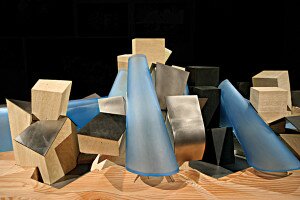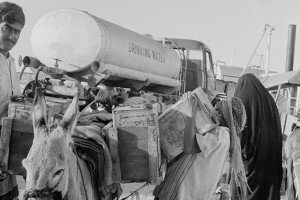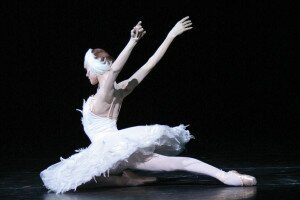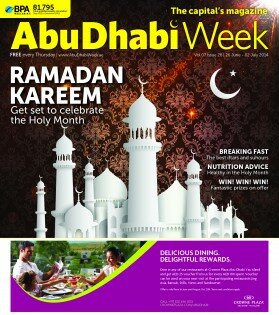How a small trading settlement transformed into a thriving capital city in only a few decades
Early times
Elephants, giraffes and turtles once roamed the countryside of the UAE, but that was millions of years ago. By the time we find the first people living here, though, it was more like the country we know today.
It seems the early inhabitants we know about – around 5500 BCE – were herders (winters by the sea, summers in the interior). The people were farmers, fishermen and traders; there’s evidence of contact with Mesopotamia and subsequently with the Greeks. Inland, settlements in what’s now Al Ain (see examples at Hili Archaeological Park) became quite large villages, probably thanks to the development of the Falaj irrigation channel.
Islam
Things didn’t change too much, though by 240 CE the Arab tribes were being influenced by Nestorian Christianity and Zoroastrianism brought from Persia. But then envoys sent by the Prophet Mohammed (PBUH) arrived some 400 years later, and the people of the UAE and Oman became enthusiastic converts to Islam.
The 16th and 17th centuries
The Portuguese arrived in 1498 and started to impose customs fees to milk the trade with Asia and India. The British replaced them in the 1630s, but the colonial principles continued. Meanwhile the Bani Yas were emerging as the major tribal grouping of what is now Abu Dhabi, centered on the Liwa oases and generally keeping away from international conflict.
Around 1760 Abu Dhabi arrived. Legend has it that a Bani Yas hunting party pursued dhabi (brown gazelles) through the shallow channel on to the island and discovered good fresh water there when they set up camp. The place became known as abu (father) of the dhabi.
The island was strategically important, offering good views of the coastline in both directions and easy to defend. The Bani Yas built a watchtower and a couple of dozen barasti (palm frond houses); by the end of the 18th century this had grown into a town of 400 dwellings and a substantial fort, Qasr al Hosn, was built. So was the watchtower that still stands in the channel at Maqta Bridge.
The 19th Century
In the 1800s, territorial disputes increasingly led the Abu Dhabi sheikhs – now bearing the name Al Nahyan – into conflict with the Qawasim who had the coastline from Sharjah up to Musandam and Qawasim’s main interest seems to have been piracy; they ran a fleet of 60 ships harassing the trade along the Gulf. The British East India Company, which
ran the highly profitable sea routes between India and Basra, didn’t like this.
In 1820 a British force crushed the Qawasim at Ras al Khaimah and imposed a General Treaty of Peace with nine local sheikdoms.
At the time Abu Dhabi was the significant regional power (alongside Oman) and could mobilise over 5,000 men. Abu Dhabi had shops and trading souks, and Sheik Zayed bin Khalifa Al Nahyan – who came to power in 1855 – was a charismatic, astute leader with a keen appreciation of both tribal politics and international diplomacy.
So Abu Dhabi’s involvement in the General Treaty of Peace was seen by the British as a useful counterpoise to the “restless habits of the Qawasim”.
A subsequent treaty in 1892 gave Britain control over foreign matters – including trade – with each emirate looking after their own internal affairs.
The 20th century
By the time of Zayed the Great’s death in 1919, Abu Dhabi was prosperous and successful. Pearls had become big business and its pearling fleet of over 400 boats was the largest in the region; agricultural output had also been improved significantly, thanks largely to renovation of the aflaaj in the Liwa and Al Ain areas. Abu Dhabi had over 15,000 residents, making it one of the largest settlements in the Gulf.
But then artificial pearls were developed, the world went into depression, and WWII meant that Abu Dhabi’s trade virtually ceased. But good news was around the corner: in 1939 Sheikh Shakhbut signed an oil exploration concession, with the British-backed Iraq Petroleum Company, and further lucrative deals followed over the next 15 years.

A parade of shops downtown during the early 1960s
Mid 1960s. Oil revenues built up speedily following the discovery of onshore oil in 1958. So when Zayed bin Sultan Al Nahyan, Zayed the Great’s grandson, succeeded as ruler in 1966, he had a full treasury and a steady income – in 1967, oil exports reached a massive £63 million. Abu Dhabi urgently needed to modernise and to invest in the future, though, and that was a priority for Zayed. A man of great insight and genuine commitment to his people, he rapidly embarked on long-overdue development projects that quickly modernised the Emirate’s infrastructure and social services. From the outset he recognised that the oil wealth needed to be managed properly, and as well as social policies – new hospitals, schools, vocational training – he also invested in agricultural and in developing non-oil industries. The city started to boom, with new roads and modern buildings appearing almost overnight. And from that starting point we can track the development of modern Abu Dhabi.
1967. The Al Ain Palace Hotel opens near the Corniche. It’s the oldest Abu Dhabi hotel still operating. Today the emirate has 148 hotels and hotel apartments and is aiming for 2.5 million hotel guests by the end of this year.
1971. On 2nd December the United Arab Emirates is established, with Abu Dhabi as its capital city and Sheikh Zayed its first president.
1972. Sheikh Zayed makes his first official visit to Britain as head of state. The UAE joins the International Monetary Fund and the World Bank.
1973. The UAE dirham replaces the Qatari and Dubai riyal, the Bahraini dinar and the Gulf rupee, all of which were being used at various times in different emirates.
1975. Maqta Bridge opens as an alternative to the ford over the shallow but potentially difficult tidal crossing. A second carriageway was added in 2000.
1976. The UAE’s first census reports a population of 655,937 at the end of 1975. Current figures put the total population at 2.33 million, with the population of Abu Dhabi Region estimated at 1.42 million. Just over 20 per cent of the total are Emiratis.
1981. The first summit of the Gulf Cooperation Council is held in Abu Dhabi; and the Abu Dhabi National Theatre opens, one of the largest and best-equipped performance spaces in the region.
1982. Abu Dhabi International Airport opens, taking over from Bateen airport as the main passenger hub.
2001. By 2000 Abu Dhabi is ready for the future. Ever increasing oil revenues, astute economic management and clever use of foreign advisors and capable overseas partners all meant that Abu Dhabi could look to the future with assurance. In 2001 the world’s tallest flagpole is inaugurated at the 30th National Day celebrations as a symbol of that confidence. It stands 122m high, but has since been eclipsed by others (all built by the same company that constructed Abu Dhabi’s). Abu Dhabi’s first two purpose-built malls, Abu Dhabi Mall and Marina Mall, both open.
2003. The Al Ain Aerial Fiesta is held; it becomes the Al Ain Aerobatic Show. The tenth edition starts on 30th November 2013 following a one-year gap. Etihad Airways is established as the flag carrier of the UAE (Dubai’s Emirates had been set up in 1985). In 2012 Etihad carried 10.3 million passengers on more than 1,000 flights per week.
2004. The first Abu Dhabi Music and Arts Festival is held, the largest classical arts event in the UAE and now an annual occasion under the simplified name Abu Dhabi Festival. In November Sheikh Zayed Bin-Sultan Al Nahyan dies and is succeeded by his son Sheikh Khalifa, both as UAE President and Ruler of Abu Dhabi.
2005. The AED 1.02 billion Emirates Palace opens as the region’s first seven-star hotel.
2006. Economic changes include moving the official weekend to Friday and Saturday to bring it more into line with Western nations. Work begins on the Abu Dhabi Vision 2030, a set of masterplans aimed at coordinating the efforts of all agencies and authorities of the government. Detailed strategies are published in 2007. Masdar, the Abu Dhabi Future Energy Company, is founded to invest in renewable energy and clean technologies.
2007. Sheikh Zayed Mosque opens. It cost an estimated $500m, took 14 years to complete, and holds approximately 41,000 worshippers. The first annual Abu Dhabi Film Festival and the first Abu Dhabi International Book Fair are held. Both have become successful annual events. Plans for Masdar City are announced: it would be the world’s first entirely self-sustaining, zero-carbon, zero-waste city for 40,000 residents and 50,000 commuters. Technology and economic changes have forced amendments to the project, but the goal remains “the world’s most sustainable city”. Masdar Institute of Science and Technology, the first tenant, moved in during September 2010.
2008. Dubai is putting the finishing touches to the Burj Dubai when the credit crisis takes hold. Abu Dhabi comes to the rescue and subsequently the world’s tallest building is renamed the Burj Khalifa, finally opening in January 2010. HH Sheikh Mansour Bin Zayed Al Nahyan buys Manchester City FC from Thaksin Shinawatra. Sheikh Mansour has a deep love of sport – he is chairman of Al Jazeera Football Club and chairman of the Emirates Horse Racing Authority. He now owns 100 per cent of MCFC through his investment vehicle, Abu Dhabi United Group. Art Paris Abu Dhabi opens. The following year the art fair becomes Abu Dhabi Art and is now established as an annual event. In November the first issue of Abu Dhabi Week appears. Someone told us “But surely there’s nothing to say about Abu Dhabi”.
2009. The first Gourmet Abu Dhabi celebrates international and regional cuisine and chefs.Terminal 3 opens, taking Abu Dhabi International Airport’s total capacity to 12 million passengers per year.In November the Yas Marina Circuit hosts the finale of the F1 Grand Prix season; it is the first day-night race on a purpose-built circuit, starting at twilight and ending under floodlights. Red Bull’s Sebastian Vettel wins, of course. The third crossing to the mainland, Sheikh Khalifa Bridge, connects Abu Dhabi to Saadiyat Island.
2010. Ferrari World opens. It’s the world’s largest indoor theme park and has the planet’s fastest roller-coaster.Zaha Hadid’s elegant Sheikh Zayed Bridge finally opens in December to relieve the pressure on Maqta and Mussafah Bridges.
2011. Capital Gate opens. Housing offices and a Hyatt Hotel next to ADNEC, it leans westward by 18 degrees – compare that with a mere four degrees for the Leaning Tower of Pisa. Luxury downtown shopping destination Central Market Souq opens on the site of the original traditional souq that had been closed many years earlier.
2012. Abu Dhabi’s tallest building opens on the Corniche – the Landmark is 324m and has 72 floors (Sky Tower on Reem, completed in 2011, has 74 floors but clocks in at only 312m).
2013. There’s a shopping bonanza – The Galleria, Abu Dhabi’s new luxury mall, opens in Sowwah Square, followed by Deerfields Town Square and World Trade Centre Mall.

Coming soon
2014. Yas Mall
2015. Louvre Abu Dhabi
2016. Zayed National Museum
2017. Abu Dhabi International Airport Midfield Terminal
2017. Guggenheim Abu Dhabi























